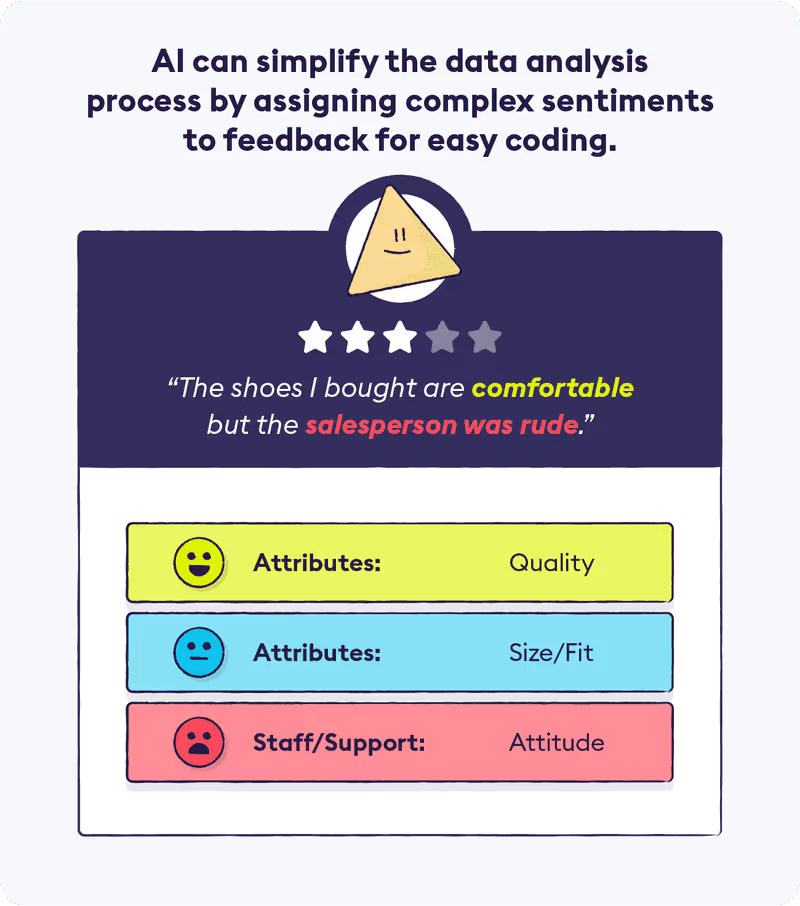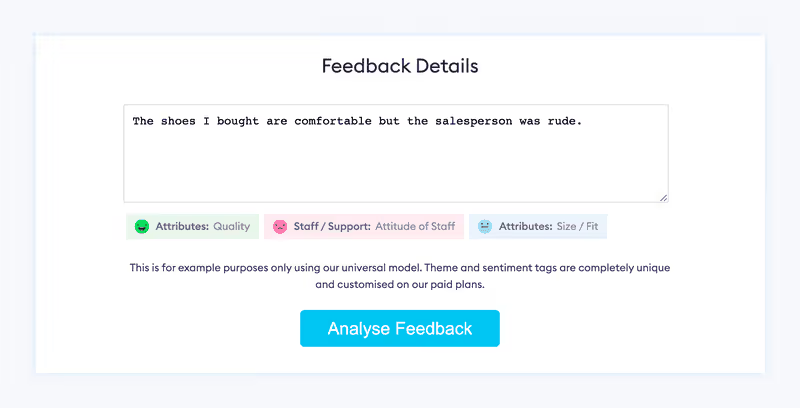Everyone has an opinion. And in today’s world, those opinions are easier to share than ever before. All of those shared thoughts and perspectives can provide valuable insights into a company’s current and future bottom line when they put sentiment analysis in action.
The process of sentiment analysis allows you to categorize written text — often in the form of customer reviews, social media posts or employee correspondence — as positive, negative, or neutral. Sentiment analysis results provide valuable insights for a business to track their brand’s reputation through customer feedback, understand the subtleties of their social media engagement, adapt to employee commentary, and conduct market research.
This guide will reveal the many concepts that go into understanding sentiment analysis, the forms it can take, potential risks, and real-world examples of the process in action. Additionally, we’ve provided a text analytics tool as a hands-on application of the concepts we’ll be outlining below.
What is Sentiment Analysis?

Sentiment analysis is a computational language processing technique that assigns weighted sentiment scores to elements of a sentence to contextually identify opinions expressed through text as positive, negative or neutral. A classification algorithm is used to identify the key phrases and score them accordingly.
To better understand how this is achieved, we first must define some of the key phrases in the world of sentiment analysis.
Important Sentiment Analysis Definitions
- AFINN lexicon: The AFINN lexicon is a simple and commonly used list of English words manually rated for their intrinsic “goodness” or “badness” by Danish professor and engineer Finn Årup Nielsen.
- Customer feedback: Customer feedback is the information and opinions supplied by customers about their experience with a product or service.
- Machine learning: Machine learning is a form of artificial intelligence that uses and studies computer algorithms that improve and adapt automatically through analysis and identification of data patterns.
- Natural language processing (NLP): Natural language processing (NLP) is the computer science application of artificial intelligence to train computers to understand the nuances of human communication through speech and written language.
- Opinion mining: Opinion mining is an alternate name for sentiment analysis.
- Polarity: In the field of sentiment analysis, polarity is the positive or negative value given to quantify the sentiment in the text being analyzed.
- Quantitative vs. qualitative: Quantitative analysis looks at hard numbers as data, whereas qualitative analysis is less tangible and examines subjective concepts and opinions.
- Sentiment library: Sentiment libraries are lengthy lists (or lexicons) of specific adjectives (such as terrific, awful, good, bad) and phrases (such as great food, horrible service, fantastic product, dreadful show) that have been identified and manually scored positively or negatively by human coders.
- Text analytics: Text analytics is the process of transforming written qualitative information into quantitative data points that can be measured for statistical analysis.
Why Do We Need Sentiment Analysis?
Between social media, online reviews, and customer surveys, the amount of customer feedback companies receive can be staggering. But how to best make use of the information you’ve collected and how to manage that process mindfully to avoid bias are questions that require consideration. In order to translate all of that qualitative feedback into actionable insights, an automated process like sentiment analysis ensures that changes can be made based on statistically significant data, rather than simplistic intuition that can lead to poor decisions.
Interpreting this mountain of data successfully can potentially translate it into a clear vision of what specific segments of consumers think about a particular product or brand. It can also provide a wealth of information revealing the state of the market from a customer’s viewpoint.
Types of Sentiment Analysis
Sentiment analysis is not a one-stop-shop. Depending on your intended application of the resulting data, you should determine in advance of which type of sentiment analysis will work best for your needs.

Fine-Grained Sentiment Analysis
Fine-grained sentiment analysis focuses on identifying the polarity of the opinion. It can be a simple positive or negative sentiment measurement. Or it can be taken to a heightened level of specificity through identifiers such as very good, good, neutral, bad, very bad.

Emotion Detection
Emotion detection is best to identify particular emotional states visible in the content being analyzed. Typically, this type requires a blend of machine learning algorithms and multiple lexicons to clearly determine the meaning behind the words used.

Aspect-Based Sentiment Analysis
Aspect-based sentiment analysis was developed to isolate and clarify customer opinions on a particular element of a product (such as the sound quality of a set of headphones).

Intent Analysis
Intent analysis strives to identify the type of objective or goals implied by the message sender, which is especially useful in customer support situations.
Sentiment Analysis Methods
There are two main methods of sentiment analysis to consider.
Rule-Based Sentiment Analysis
Rule-based sentiment analysis uses a Natural Language Processing algorithm to identify words within the analyzed text that match up to an existing sentiment library, and then calculate if there are more of the positively or negatively scored words. If the text is determined to contain an abundance of positive words, it is deemed to have a positive polarity score.
To achieve more valuable results, those scores often need to be combined with additional pre-determined rules that compensate for language variances that may influence the intended meaning of the words chosen. Concepts such as sarcasm, irony, and humor are not easily interpreted by computers and must be accommodated for in the programming of rule-based sentiment analysis systems.
Automatic Sentiment Analysis
Automatic sentiment analysis is also known as Machine Learning (ML) Based Sentiment Analysis. The use of machine learning classification algorithms in this method allows for faster processing of data with greater precision and statistical accuracy to calculate the gist of the original message.
This method is much more prevalent these days, as rule-based sentiment analysis is often used only as a first step, in essence laying the groundwork for the training of a future machine learning algorithm. Automatic sentiment analysis is widely believed to provide better depth of understanding of the author’s original intended meaning.
Free Sentiment Analytics Tool

A free theme and sentiment analyzer like the one pictured here offers a quick way to gather deeper insight into your customer feedback. Simply type the text of the comment you wish to measure in the box, click Analyse Feedback, and you’ll get a result identifying the positive and/or negative sentiments.
A quick tool like this provides straightforward access to better understanding your customers and their views of your business and/or products. And these tools can be customized to better suit the needs of your specific company to best make use of the data collected across your customer feedback pipeline.
Potential Pitfalls of Sentiment Analysis
Sentiment analysis is not an exact science. Below are some of the challenges to keep in mind when you put the technique to use to translate your qualitative data into quantitative results.
- Determining context: A basic sentiment analysis algorithm is not capable of interpreting the context surrounding a line of text. Due to that fact, the algorithm must be written to include an added element that will take the context of the full message into account.
- Identifying tone and subjectivity: While identifying tone may not be a major issue, programming an algorithm to determine subjectivity or objectivity is a bigger challenge. This can be addressed by a deeper sentiment library with a broader scope of verbiage options to consider in the calculations.
- Recognizing sarcasm and irony: The subversive nature of sarcasm and irony are often a roadblock in NLP. The algorithm simply takes a humorous play on words at face value, thus misidentifying the sentiment. Avoiding these issues requires a carefully trained NLP sentiment analysis system based on deep context analysis and a variety of sample texts.
- Neutral tone definition: When the analyzed text doesn’t include any language signifying positivity or negativity, you are left with a neutral tone that basically simply states facts. These messages can be identified by training your algorithm to recognize what is not present, as in if there are no positive or negative sentiments expressed, it would be labelled as neutral.
Sentiment Analysis Uses and Examples
The usefulness of sentiment analysis is shown by the many industries the process serves. From retail to human resources, finance to marketing, these are some of the key areas where sentiment analysis consistently delivers useful results.
Voice of the Customer (VoC)
Collecting, analyzing and then actually listening to customer feedback is critical for all businesses to survive. Identifying the Voice of the Customer (VoC) for your company requires conducting surveys (such as the NPS Score survey) and extracting insight through sentiment analysis of survey results and additional customer reviews. Better understanding of the expectations, wants, needs and dislikes of your customers through VoC makes it possible to monitor for changes in customer perceptions of your company and visualize the nuances of customer experience through quantitative data.
Sentiment Analysis Use Case:
HelloFresh
food delivery service provider
Sentiment analysis revealed:
Children disliked recipes for casseroles because they couldn’t see what was in their food.
Actionable result:
HelloFresh adjusted the types of recipes provided to families, demonstrating their acknowledgement of the consumers’ needs.
Voice of the Employee
The Voice of the Employee (VoE), similar to the Voice of the Customer (VoC), is revealed through gathering employee feedback to identify the needs, wishes, goals, and preferences of the collective staff of that company. Through employee engagement programs, internal survey and direct feedback, VoE appraises both specific needs such as salaries, health benefits, and career paths, as well as implicit emotional needs for respect and security in the workplace through sentiment analysis.
Sentiment Analysis Use Case:
Kmart Australia
grocery super store chain
Sentiment analysis revealed:
Kmart employees cared deeply about their tenure at the company.
Actionable result:
Executives created staff name badges that highlight service recognition and are presented at workdate anniversary celebrations.
Market Research
When applied to the world of marketing, the resulting insights achieved through sentiment analysis can range from the monitoring of your brand versus a competitor to comparisons of the reception a product received in new international markets. These powerful algorithms can provide measured perspectives on predictive tasks, from high-level industry campaign concepts to the minutiae of the best wording to use on a landing page.
Sentiment Analysis Use Case:
Audi vs. BMW vs. Mercedes
car industry research
Sentiment analysis revealed:
Audi’s positive polarity score was higher than both BMW and Mercedes, indicating higher overall customer satisfaction of Audi consumers.
Actionable result:
Marketers focused on providing offers via Audi’s page in order to circulate them to a higher percentage of satisfied customers.
Stock Market Analysis
The widespread use of social media platforms creates a space for investors to share their thoughts and opinions. All of that content can be examined through a sentiment analysis system to deliver a sense of what people think about a particular stock. These findings then become important predictors of stock fluctuations.
Sentiment Analysis Use Case:
Amarin Corporation
biotech company
Sentiment analysis revealed:
Amarin Corporation had the highest number of positive tweets among publicly-traded biotech companies after news of their medical research success.
Actionable result:
The stock (NASDAQ: AMRN) sky rocketed up over 300% after the positive news, as predicted by the sentiment analysis.
Sentiment analysis is an essential tool that can provide actionable insights to help your business improve on multiple fronts, from monitoring your brand to customer experience to employee satisfaction. Conducting business in the 21st century calls for greater understanding of your market, your customers, and your staff to achieve success, making the benefits of sentiment analysis invaluable.





.avif)

